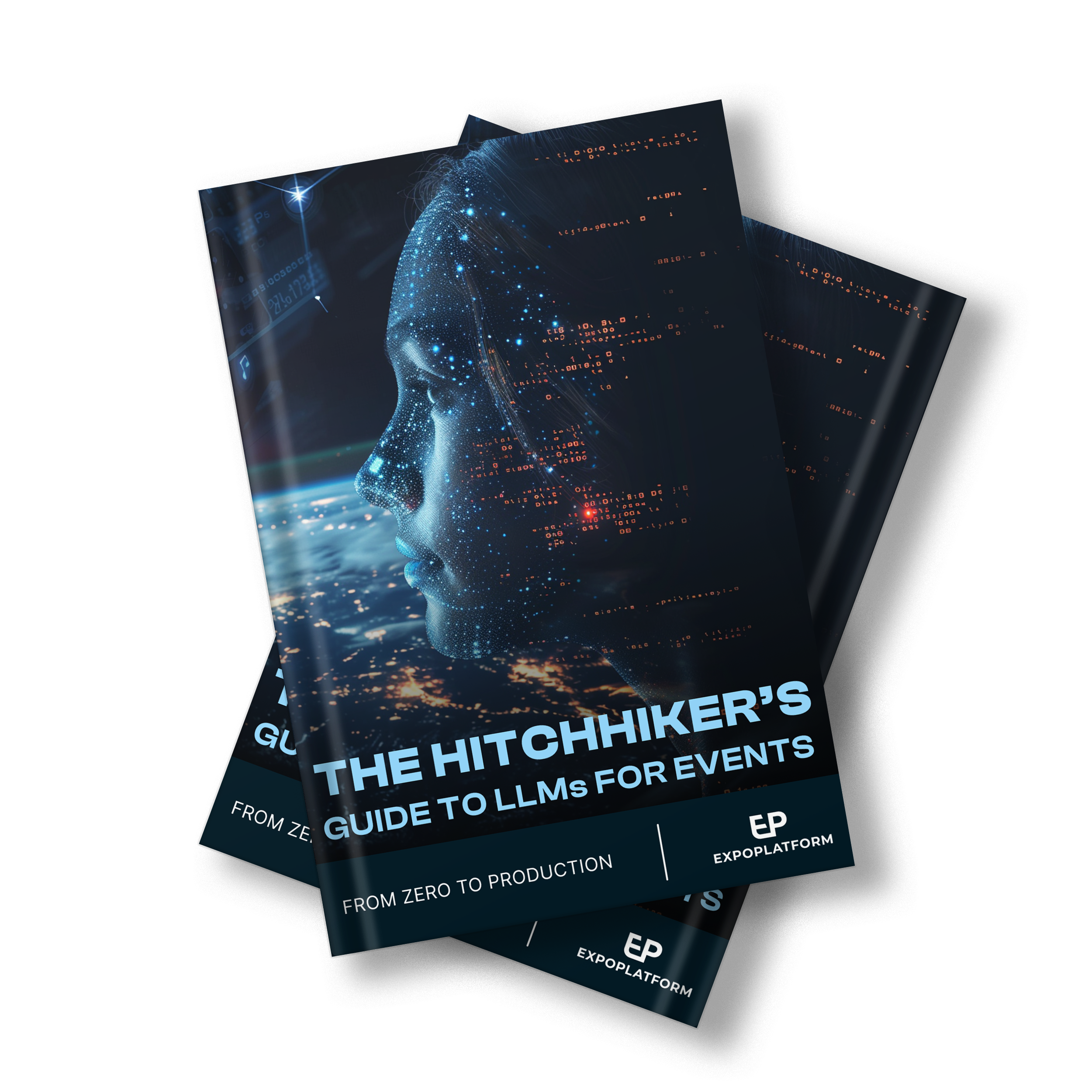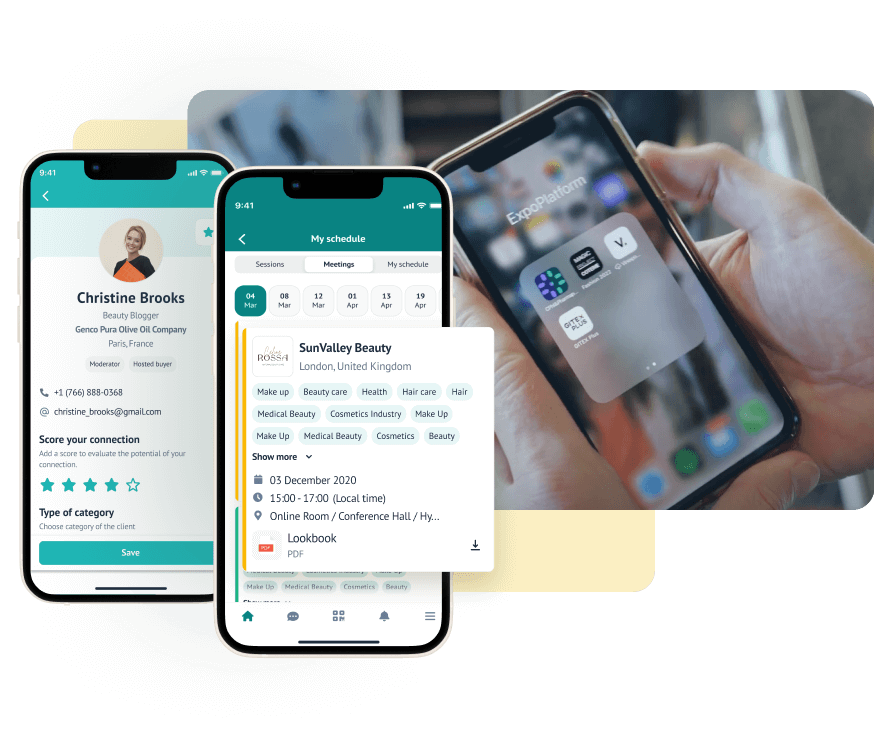
The essential Event App guide for tradeshows
If you’ve been to a big industry event lately, chances are you were asked to download an event app.
These nifty digital sidekicks have quickly become the mainstay of leading shows like IMEX and GITEX.
Event apps simplify your experience, providing quick access to schedules, badge scanning, interactive maps and other useful features.
This enables visitors and exhibitors to fully engage with the event’s offerings and make the most of their participation.
We have put together a short guide to help you understand how event apps help deliver a better experience at tradeshows. Here’s what you will read:
- How mobile apps have become integral to the digital transformation of events
- Applications and benefits of using event apps at tradeshows
- Event app features to create smart audience experiences
- How an event app fits into the attendee’s journey
- Case Studies
How mobile apps have become integral to the digital transformation of events
Mobile event apps have been critical in driving tech-enabled experiences at exhibitions and tradeshows.
What began as simple value-add tools for event check-ins and scheduling have evolved into sophisticated platforms that boost engagement, ROI and year-round value.
As mobile penetration increases globally and people get access to more advanced tech in their pockets, the use of event apps is expected to grow exponentially.
According to the Insight Partners, the event apps market is projected to increase from $1.20 billion in 2022 to $2.65bn by 2028, growing at a CAGR of 14% ().
Modern event apps used at leading tradeshows include a range of advanced features designed to craft intelligent and immersive experiences. Some of these are:
- Lead Intelligence Tools: • Capture and qualify leads in real-time • Provide instant analytics on attendee interactions
- Exhibitor Manual: • Digital access to crucial information for exhibitors • Streamline communication between organizers and exhibitors
- AI-Powered Matchmaking: • Suggest relevant connections based on attendee profiles and interests • Enhance networking opportunities
- Hosted Buyer Programs: • Facilitate pre-scheduled meetings between buyers and sellers • Manage appointments and track ROI
- Interactive Floor Plans: • Navigate complex event spaces with ease • Locate specific booths or sessions quickly
- 365 Marketplace: • Extend the event beyond its physical dates • Provide year-round engagement and business opportunities
- Online Community: • Foster ongoing discussions and networking • Share content and maintain connections post-event
Applications and benefits of using event apps at tradeshows
Tradeshows are hubs of opportunity, offering rich prospects for networking, learning and enhancing brand visibility.
However, the limited timeframe, packed schedules and a labyrinth of exhibitor booths can overwhelm even seasoned attendees.
Mobile event apps act as digital concierges, streamlining the tradeshow experience.
These tools revolutionize event navigation and engagement, offering a suite of powerful features at attendees’ fingertips.
1. Social media integration and targeted messaging
👉 Application: Event apps integrate social media platforms, offer in-app messaging systems and utilize location-based services.
☑️ Benefit: Facilitates meaningful interactions, allows for targeted messaging based on attendee interests and preferences and enhances engagement through multiple digital touchpoints.
2. Dynamic event management and attendee coordination
👉 Application: Apps provide instant notification systems for real-time updates and changes, including invite errors, speaker cancellations, new attendee registrations and supplier quote issues.
☑️ Benefit: Streamlines planning and logistics by enabling quick resolution of last-minute changes or disruptions, improving overall event coordination.
3. Customized agenda creation
👉 Application: Apps feature personal schedule builders within the full event program, allowing attendees to add sessions of interest to their individual agendas.
☑️ Benefit: Saves time and increases efficiency for attendees by allowing them to plan their optimal trade show experience and focus on their key areas of interest.
4. Real-time event broadcasting and information dissemination
👉 Application: Apps offer live streaming capabilities and instant content-sharing features for text, video and image messages through push notifications.
☑️ Benefit: Delivers real-time content updates, ensuring all attendees have access to important information regardless of their location within the venue.
5. Seamless system integration
👉 Application: Enterprise-level apps provide easy API integration with existing business systems and partner APIs.
☑️ Benefit: Creates a cohesive experience without custom coding, automating data flow across different platforms and eliminating the need to learn multiple systems.
6. Amplified marketing potential
👉 Application: Apps include features for creative, gamified promotional activities and product showcases, allowing for innovative mobile marketing strategies.
☑️ Benefit: Improves marketing efforts by enabling innovative and captivating ways to promote businesses, products, and services, capturing audience attention more effectively.
7. Instant customer support
👉 Application: Apps incorporate real-time support chat features with access to real-time data for customer support staff.
☑️ Benefit: Enhances customer service by allowing immediate resolution of attendee issues, boosting satisfaction and loyalty through prompt and informed assistance.
8. Beyond-the-event brand awareness
👉 Application: Apps include sections for special offers, promotional codes, or exclusive deals for events, products and services.
☑️ Benefit: Increases brand awareness by offering tangible value to customers beyond traditional marketing channels like emails and social media posts.
9. Persistent networking and engagement ecosystem
👉 Application: Apps transform into year-round platforms for continued interaction after the physical event, creating a 365 community platform.
☑️ Benefit: Facilitates ongoing networking and engagement opportunities, allowing buyers and sellers to connect, interact, and make business decisions throughout the year.
10. Real-time event feedback
👉 Application: Apps feature in-built survey and polling tools for gathering attendee feedback before, during and after the event.
☑️ Benefit: Enables understanding of audience expectations, allows for quick implementation of real-time changes and informs strategies for future events based on comprehensive feedback.
11. Maximizing ROI through sponsorships
👉 Application: Apps offer prime digital space for sponsored content and advertisements, including strategically placed ads, splash screens and banners.
☑️ Benefit: Increases ROI for organizers through paid sponsorship and monetization opportunities, while providing higher brand visibility for sponsors in the digital event space.
Let’s have a detailed look at the app features that create a smart live event experience
Event app features to create smart audience experiences
1. Standalone as well as a container app
Apps can be developed either as standalone versions tailored for a specific event or as container apps encompassing multiple events of a similar type.
Container apps enable users to access various events and their associated content with a single download.
For instance, consider an organizer hosting several fashion award shows throughout the year. A container app can consolidate all these events under one platform, eliminating the need for separate apps for each show.
Users can easily access a specific event by selecting it from a list within the app. This design allows both new and past events to be added and viewed seamlessly.
This approach is particularly useful in light of Apple’s iOS store spam guidelines, which penalize multiple versions of similar apps.
Guideline 4.3 “Don’t create multiple Bundle IDs of the same app. If your app has different versions for specific locations, sports teams, universities, etc., consider submitting a single app and provide the variations using in-app purchase.”
“Spamming the store may lead to your removal from the Apple Developer Program.”
2. Customised homepages
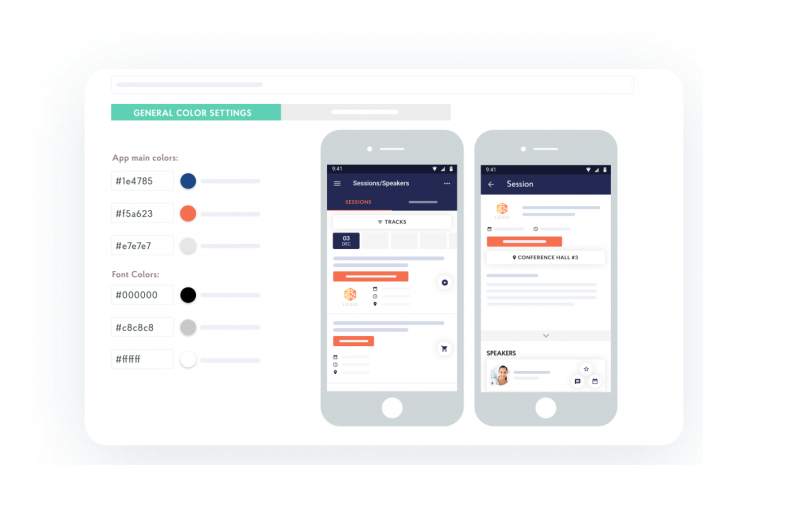
Craft your event’s digital front door: designing the perfect app home screen
Your app’s home screen is like the lobby of your event – it’s the first impression users get. Let’s make it count!
Think of it as your event’s digital welcome mat. It should offer:
- Easy login access
- Quick profile peek
- Essential contact details
- Shortcuts to must-have resources
But it’s not just about information – it’s about making a splash! Your home screen should be a visual treat that captures your event’s vibe.
As you’re brainstorming, ask yourself:
- What’s the look and feel I’m aiming for?
- How can I showcase different content types?
- Where should I place my navigation tools for maximum intuition?
- What sponsor opportunities can I create here?
- Any special features I want to highlight?
Here’s the kicker: a home screen that wows doesn’t just look pretty – it’s your secret weapon for boosting app exploration and ramping up event engagement.
Remember, your home screen isn’t just a page – it’s an invitation to dive into your event experience!
3. Agenda and streaming sessions

Enable users to customize their event agendas with detailed session information, including timings and locations. This feature ensures participants can focus on content most relevant to their interests.
Incorporate live video streaming within the app, allowing organizers to gauge audience reactions and gather real-time feedback. Additionally, offer on-demand video access for missed sessions, providing flexibility and maximizing content value.
These features combine to create a personalized, interactive event experience that caters to diverse attendee needs while providing valuable insights for organizers.
4. Meetings and messaging
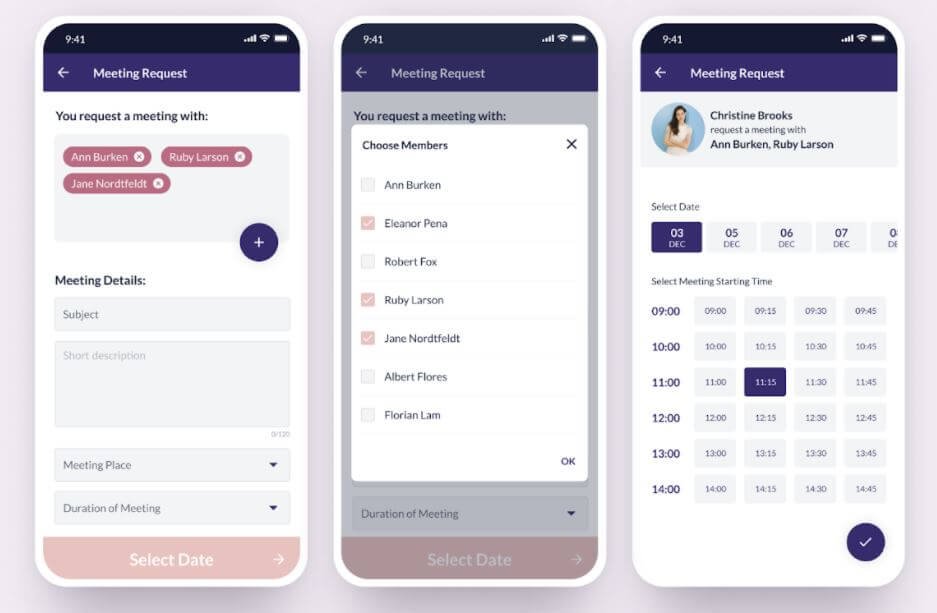
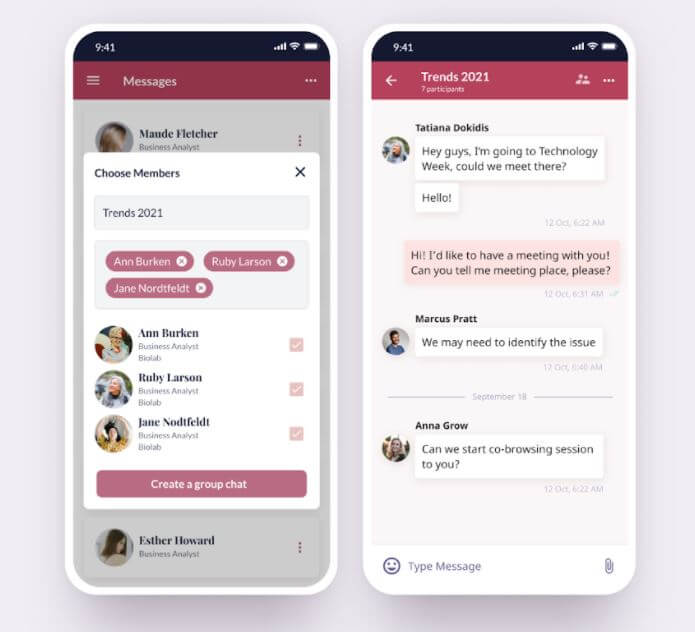
Integrate calendar management and networking tools to enhance attendee interactions:
- Meeting Scheduler: Enable users to set appointments, access meeting minutes, and exchange documents directly within the app.
- Internal Messaging: Provide a private communication channel for attendees, eliminating the need to switch between platforms.
These features foster knowledge sharing, networking, and community building, creating a more cohesive event experience. By streamlining interactions, attendees can maximize their time and make meaningful connections efficiently.
5. Lead scanning
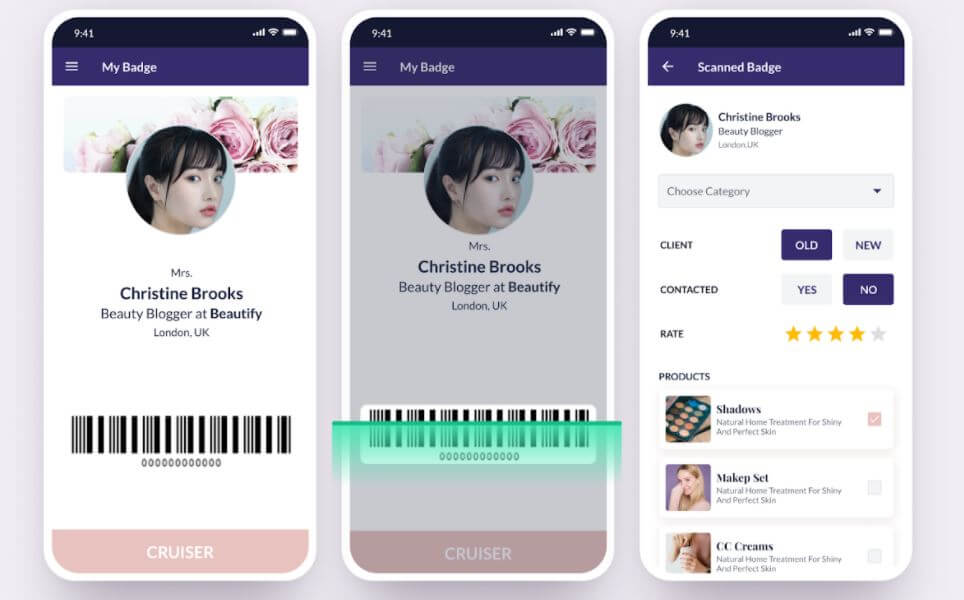
Incorporate advanced lead capture technology to enhance exhibitor-attendee interactions:
- Real-time data capture: Enable participants to collect and qualify leads instantly through the app.
- Multi-format scanning: Provide barcode and QR code scanning capabilities for efficient information gathering.
- Lead qualification: Allow exhibitors to rate, categorize, and annotate leads for more effective follow-up.
- Unified dashboard: Consolidate all lead data, both online and offline, into a single, comprehensive view for exhibitors.
This integrated approach optimizes the lead generation process, facilitating more meaningful connections and improving post-event follow-up efficiency.
6. Real-time exhibitor leads
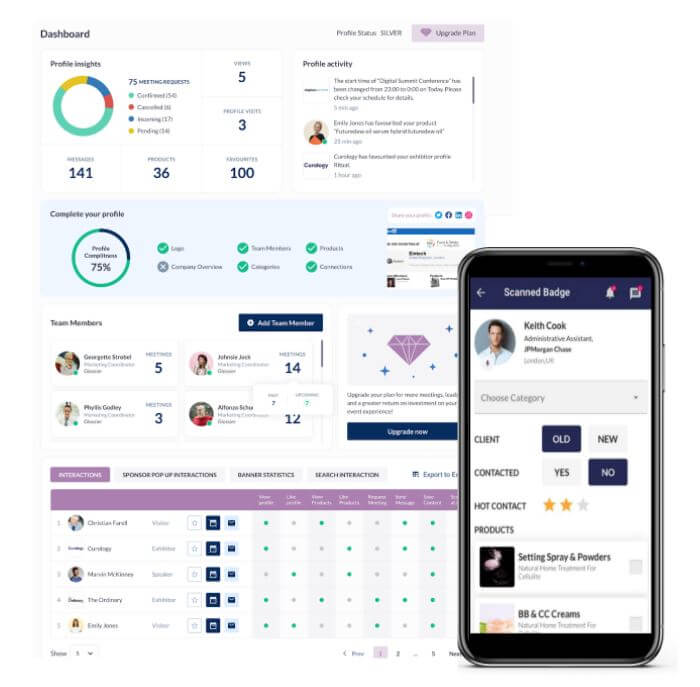
Elevate exhibitor and sponsor experiences through comprehensive performance analytics:
- Real-Time statistics: Deliver up-to-the-minute data on exhibitor performance and engagement metrics.
- Self-Service dashboard: Provide a centralized platform for lead management and interaction tracking, including banner ads, pop-ups, and search result visibility.
- Integrated lead capture: Incorporate live event badge scanning and lead scoring directly into the dashboard, bridging physical and digital interactions.
- Campaign performance insights: Enable exhibitors to assess marketing effectiveness promptly, facilitating agile strategy adjustments.
This results in improved exhibitor ROI, allowing for informed decision-making and optimized engagement strategies throughout the event lifecycle.
7. Interactive floor plan with bluedot wayfinding
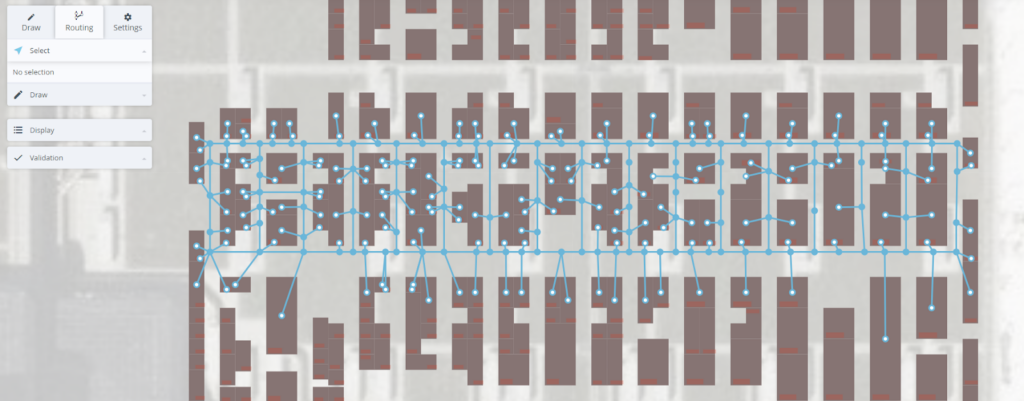
Implement indoor mapping and wayfinding for seamless attendee movement:
- Intuitive Navigation: Offer an indoor GPS-like experience with bluedot technology.
- Comprehensive Coverage: Include meeting rooms, breakout areas, and exhibitor booths.
- Custom Routing: Enable point-to-point directions based on user input.
- Interactive 3D Floor Plan: Provide a detailed, custom layout of the venue.
- Mobile Integration: Access the floor plan directly through the event app.
This feature streamlines attendee movement, enhancing overall event experience and efficiency.
8. Monetisation through banner ads and splash screens
Virtual sponsorship options can be offered through:
- Splash screens that appear while the app loads
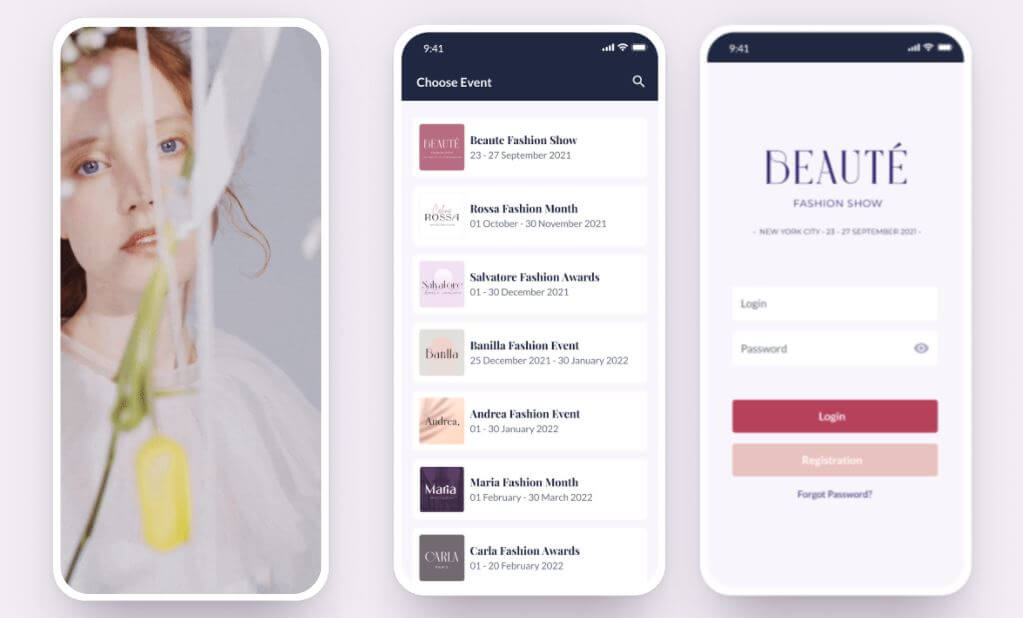
- Premium exhibitor profiles with header images
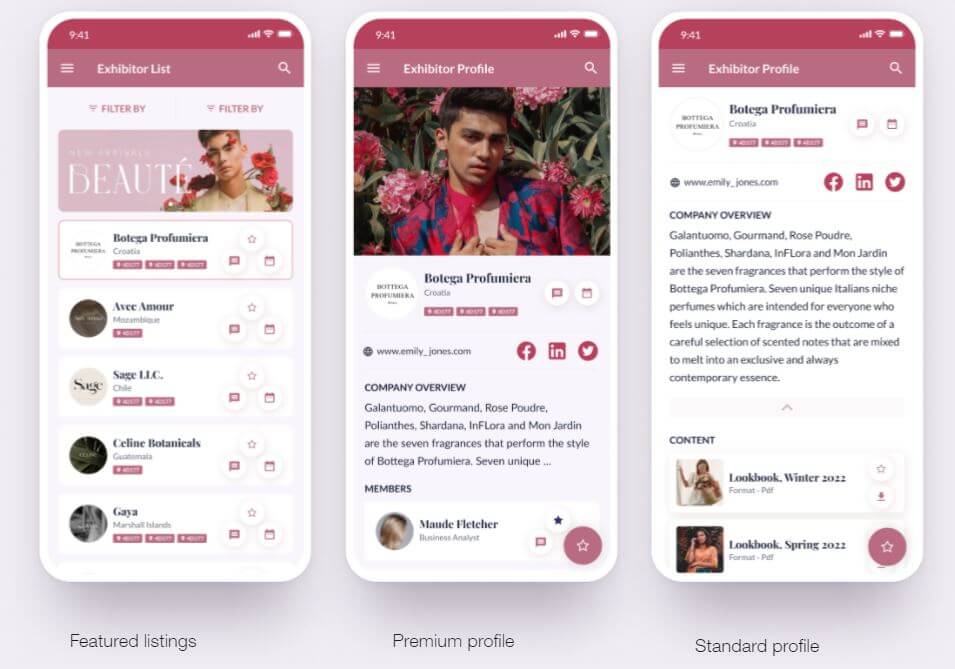
- Mobile banner ads with featured exhibitors, products, speaker listings, visitor pages at the top.
The banners can be set up from the admin panel, allowing you to turn on and off those in the mobile app.

9. ‘Product Tinder’ view
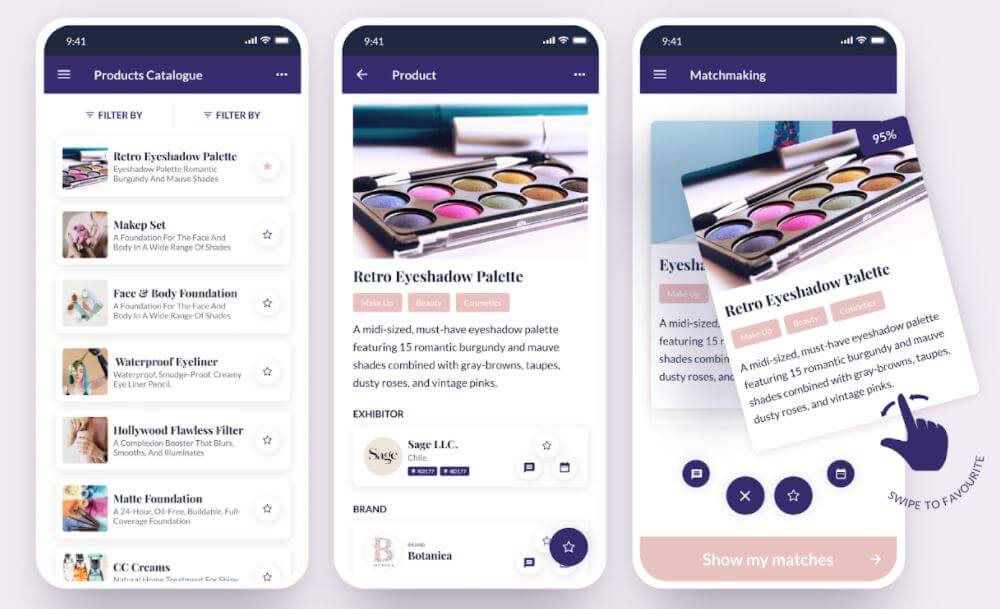
The product Tinder view is an intuitive product matchmaking system that enables:
- Smart recommendation: Utilize AI algorithms to connect buyers with relevant products.
- Interactive catalog browsing: Enable users to efficiently navigate through product offerings with a familiar swipe interface.
- Instant product evaluation: Allow visitors to quickly favorite or pass on items, streamlining their product discovery process.
- Enhanced exhibitor reach: Facilitate broader exposure for exhibitors’ products to potential customers.
- Accelerated buyer journey: Expedite product discovery for attendees, optimizing their time and improving overall event experience.
10. Marketing materials
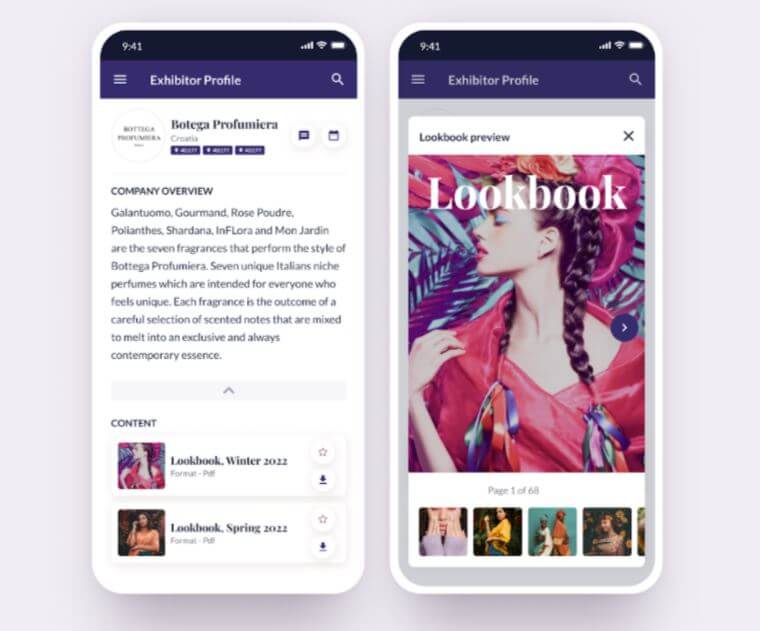
Equip visitors with essential marketing materials to help them swiftly make informed decisions about a product or service.
This can be achieved through a PDF lookbook featuring scrollable images that provide an in-depth view of the exhibitor profile.
The lookbook includes comprehensive details such as an image gallery showcasing the product from multiple angles, walkthrough videos, FAQs, reviews and testimonials from past buyers, and links to social media profiles.
These resources are available within the content sections of exhibitor or product profiles, facilitating informed networking.
11. Exhibitor catalogue search
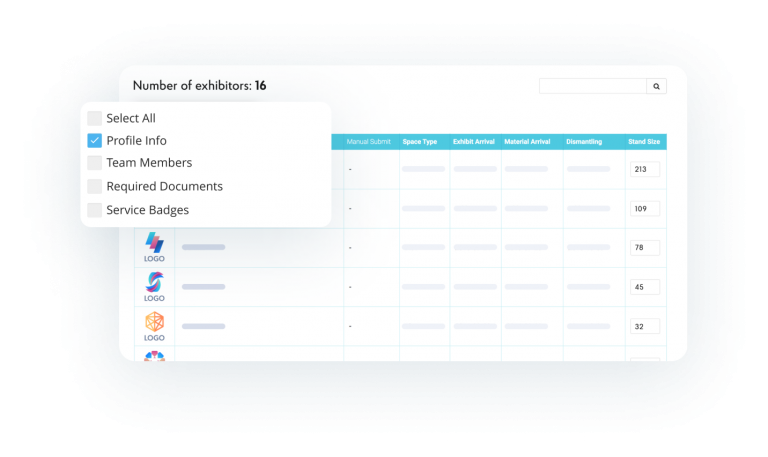
The exhibitor catalog is a section within the app that showcases a collection of exhibitor profiles.
Users can sort and filter this collection based on their specific business needs.
Selecting an exhibitor profile provides access to comprehensive details and full information.
12. Permission levels for different user types
Organisers can decide and give selective access to the exhibitor’s team as well as attendees. For example, exhibitors are allowed a certain number of members or products they can showcase unless they upgrade their accounts.
Similarly, attendees who register for free won’t gain access to content materials or take part in training sessions without upgrading.
How an event app fits into the attendee’s journey
An attendee’s journey typically begins online. They receive email or social media invitations to an event or encounter advertisements promoting an upcoming show.
Upon clicking the invitation or ad, they are directed to the event website, where they can find detailed information and register if interested.
Once registration is confirmed, attendees are given the option to download the mobile app for the latest updates and to enrich their event experience.
Let’s explore the mobile app experience for both visitors and exhibitors at various stages of the event.
Before the event
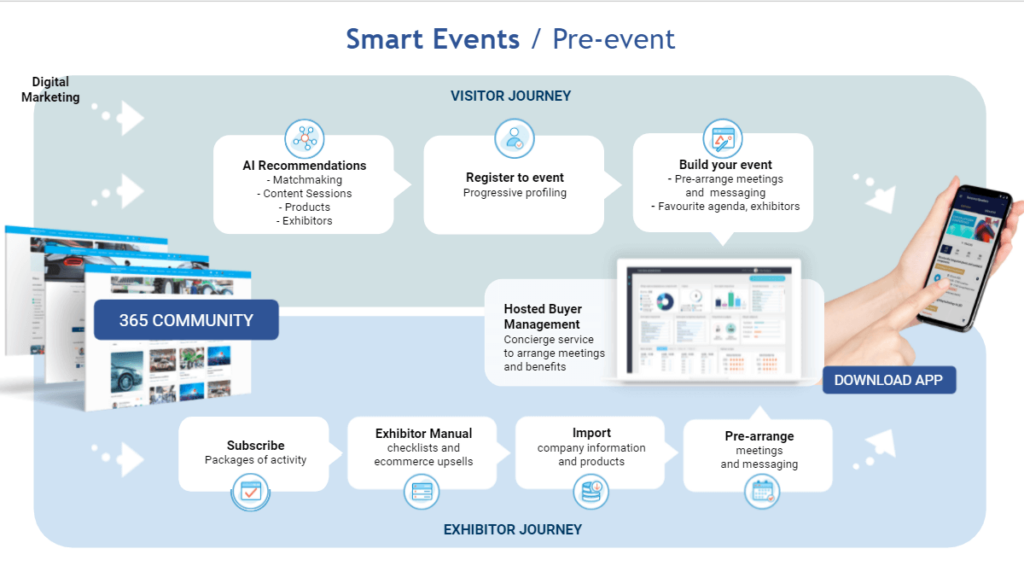
Visitors have the option to join the event as part of the 365 community or participate as new attendees.
Being part of this community provides early access to session details, products, and exhibitors. AI-driven matchmaking recommendations save their preferences during event registration, aiding the organizer in progressive profiling.
For visitors, a mobile app offers the following benefits:
- Enables the creation of a personalized event agenda by favoriting sessions.
- Facilitates the pre-arrangement of meetings and messaging.
- Allows for research and connection with exhibitors.
Exhibitors can leverage the event app to:
- Schedule meetings and send messages.
- Import company details.
- Set up checklists and e-commerce upsells.
- Subscribe to the appropriate exhibitor activity package based on their business needs.
During the event
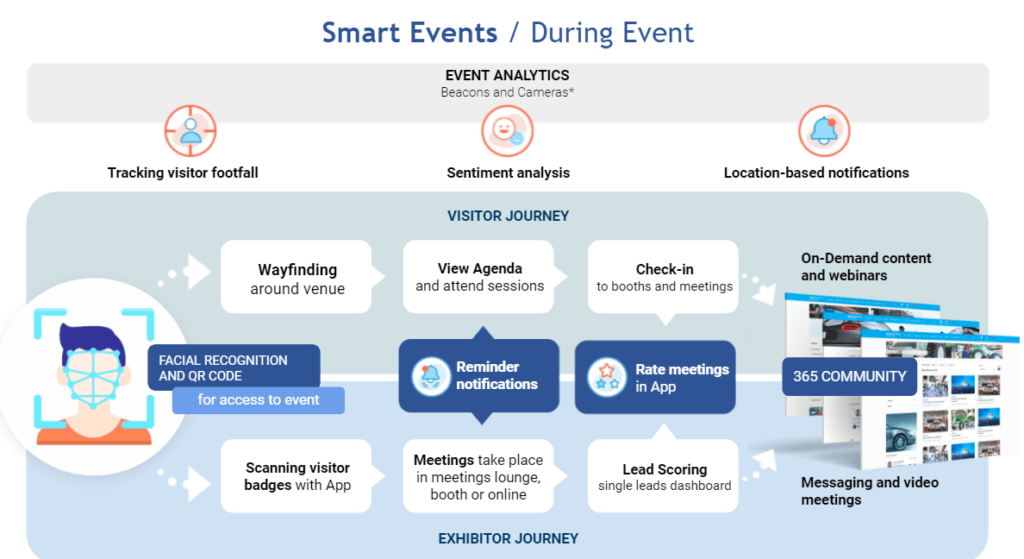
Once the event is live, visitors can use the mobile app to:
- Use the wayfinding feature to navigate around the venue
- View sessions agendas to attend the relevant ones
- Check in to booths and meetings
- Rate and review meetings
During the event, the mobile app helps the exhibitors:
- Scan visitor badges – badgeless scanning is possible with apps
- Provide location-based notifications by connecting apps to beacons and cameras
- Score leads through the leads dashboard
- Get access to analytics like tracking visitor footfall
After the event concludes, the app is utilized to distribute feedback surveys, grant access to on-demand content and webinars, and onboard participants to the 365 community. This continuous engagement allows visitors and exhibitors to stay connected year-round and provides organizers with a ready pool of participants for future events.
Case Studies
IMEX Frankfurt 2024
<img>
IMEX Frankfurt is Europe’s premier tradeshow for the global meetings, events and incentive travel industry. It provides exhibitors with a platform to showcase their products and services to an international audience of buyers and decision-makers.
ExpoPlatform worked with the IMEX Group to introduce a range of improved digital features in the web and mobile app to enhance experiences, making it more streamlined for participants.
Results: IMEX Frankfurt 2024 recorded unprecedented engagement numbers powered by tech, surpassing last year’s figures by a significant margin.
- 87% of all meeting requests accepted
- 53,800 total confirmed meetings – up 13% from 47,700 in 2023
- 82,726 unique badge scans – up 11.5% from 74,221
- 461,662 favorites – up 63% from 284,000
More than 50,000 meetings were set up before the event even got underway, with thousands more being confirmed during the show through the web platform and app.
IMEX CEO Carina Bauer said: “With ExpoPlatform’s help we’ve built out a more robust, personal and intuitive customer journey – a development that’s been in our sights for a while.
“And now that our show app is more integrated and packed with core, hard-working new features, we have a wealth of strong data in our hands.
“This will allow us to more accurately define – and design – enhancements that will benefit all our clients in the future.
GITEX Global 2023
<img>
GITEX Global (Gulf Information Technology Exhibition) is the world’s largest tech showcase, spotlighting the latest trends, innovations, and advancements in AI, cybersecurity, mobility, sustainable tech, and more.
ExpoPlatform worked with the organizer to create an all-in-one smart event platform with advanced features to set up hosted buyer meetings, drive quality engagement and maximise lead generation.
Results:
Our platform empowered DWTC to create a highly customized event management experience for themselves and uniquely tailored journeys for their customers.
With nearly 60,000 downloads of the GITEX Plus app, attendees could navigate the show effortlessly.
They had easy access to sessions, exhibitors, products, and other attendees, enhanced by AI recommendations and extensive filters, allowing them to maximize their time and derive maximum value from GITEX.
A major highlight of the show was the in-app digital badge scanning and lead retrieval, which resulted in an impressive 698k+ unique lead scans. This feature helped exhibitors streamline their sales pipelines and significantly boost their ROI.
We hope you enjoyed reading this article and found it useful. Want to learn more about supercharging your event experience with mobile apps? Grab our free Event Handbook to get started
There's more you might like
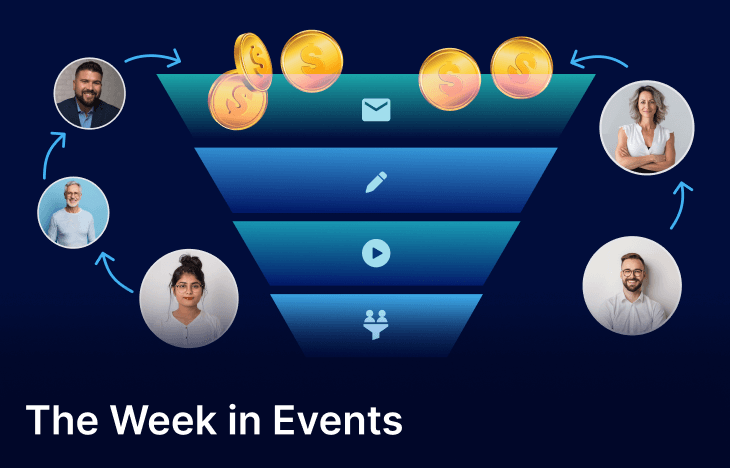
92% plan to improve post-event follow-ups – Forrester
More than 90% of event professionals plan to improve their attendee follow-up strategies to maximize ROI, according to a new study. The Forrester study also highlights eight key trends eventprofs should focus on this year. Get the complete details below. Here are the top headlines for your weekly event news updates: 92% aim to prioritize ...

Event marketing budgets grow at UK record rate: IPA report
Event budgets outpaced other marketing departments to grow at the highest rate on record across the UK, according to a new report. The latest Institute of Practitioners in Advertising (IPA) study marks the ninth straight quarter of growth in this area and the highest increase in 11 years of data tracking. Read more about it ...

Events hit as UAE records heaviest rain in 75 years
Sweeping floods disrupted event operations as the UAE grappled with the most severe rainfall in nearly 75 years. The deluge led to several cancellations and postponements even as authorities acted to restore normalcy. That’s the main event story – read more about it below. Here are the full headlines of this week’s event news updates: ...

